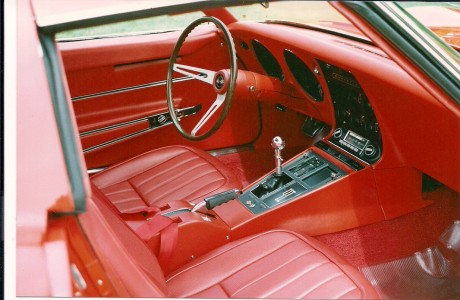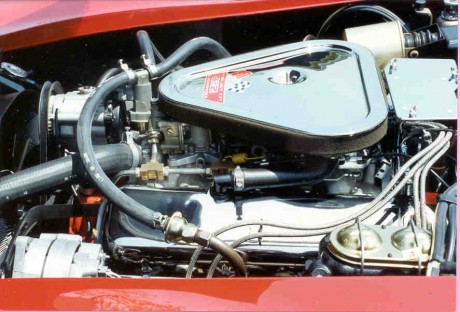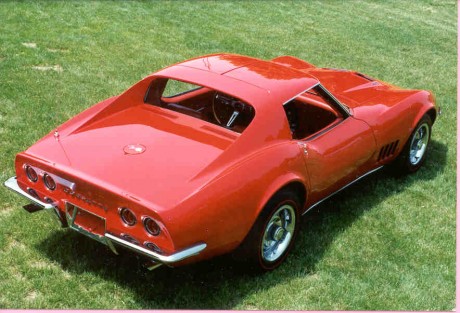1968 Corvette L89 Restoration Article
The 1968 Corvette was a completely new animal in comparison to the 1967 version. This new Corvette featured a completely new exterior and interior. Although the wheelbase and much of the chassis was maintained, the new car featured for the first time removable roof panels (coupe) and a removable rear window. The headlights remained hidden on the ’68, but now “popped up” instead of revolving into position. They also were vacuum operated, which replaced the electric headlight system from the ‘67 model year. The ‘68 Corvette also has a unique door opening latch. The mechanism consists of a finger depression plate and a door opening button. In 1969, the button was eliminated and only the plate was utilized for door entry. Also featured was the unique hidden windshield wiper system. This system was vacuum operated and proved to be a troublesome feature of the car.
The interior in the ‘68 Corvette was revised and had considerably less leg and head room than in previous years. The seat position was positioned at a more radical rake angle, which created a semi-reclining passenger arrangement. The rest of the interior was new, including new console panel and redesigned gauges. A new fiber-optic light monitoring system was standard and was displayed in the center console panel. 1968 was the first year that the Corvette did not feature side vent windows as well. The 1968 Corvette was the last Corvette to have the ignition switch on the dash.
There were several drivetrain changes that were made in this model year as well. The most notable difference from 1967 to 1968 was the addition of the Turbohydramatic 400 transmission to the Corvette model. The turbo 400 started production in 1965 in 396/325HP passenger cars, but Chevrolet had to wait until 1968 to include it as a Corvette option due to body clearance problems.
Another change worth noting here is the movement of the battery position to the interior of the car, specifically behind the front seats. This was initially done to provide better access to the battery, but a small advantage was also seen in slightly better weight distribution of the car. The rally wheel width was also increased in 1968 to 7 inch rims. The 1967 used a 6 inch rim and the 1969 used an 8 inch rim, which left the 1968 Corvette with the only 7 inch rally rim ever offered on a Corvette.
The feature car here was formally owned by Dave Roberts of Springfield, Ohio. As you can see from the photographs it has one of the most desirable color combinations to ever grace the ‘68 Corvette. With the #974 Rally Red exterior paint and the #407 red interior, the car draws more attention than a polka-dotted elephant on Sunset Strip. It also draws a lot of judge’s attention to boot.
To say this car has been restored is an understatement. The car sat idle for about 3 months before David started taking the car apart for restoration. It received the full frame-off treatment over the next 2 year period. During this time David was busy crawling under everyone’s 1968 Vette to obtain precise detailing information for his own car.
By the summer of 1990, the car was finally presentable and the decision was made to make the trip to Bloomington. Even though his only intent that year was to show the car, his was one of the very few 1968 L89 cars in attendance. It was at this meet that David decided to “fine tune” the car and prepare the car for Bloomington Gold in 1991.
Even though the car was very nice at the time, David soon found out that it’s the little things that make a Bloomington car. It took David almost a year to prepare the car to compete in a Bloomington Gold arena. He took the car to an NCRS local meet about 3 weeks before Bloomington Gold to see how the car would do. He was pleasantly surprised when the car took one of the few top flight awards handed out that weekend, but there were still several areas in which the car could be improved. Most of the flaws in the car were then corrected in that 3 week window before Bloomington Gold.
Finally, after two years of hard work, patience and a ton of greenbacks, the car was ready for the Bloomington Gold judging field. The wait paid off with the car receiving the Gold Certificate that weekend.
Where is this Corvette now? Do you or someone you know…happen to know where this car is now? If yes, please let me know via email at features@alancolvin.com! Little is known about this particular car’s history. David originally purchased the car from a car collector in North Carolina on January 30, 1988. The original invoice is from Nuzum-Cross Chevrolet, Newton, N.C. The car was originally bought by John Henry Elmore on March 13, 1968.
1968 L-89 Corvette
427/435HP
DRIVETRAIN ASSEMBLY BREAKDOWN
1968 L-89 Corvette
427/435 HP
Drivetrain Assembly Breakdown
Block – 427/435 HP
#3916321 Early
#3935439 Late
Engine Code Suffix – IU
Cylinder Heads – 2.19 Intake, 1.72 Exhaust, Aluminum casting #3919842
Crankshaft – Forged, tuffrided, cross-drilled, casting # varied
Rods – Hi-performance dimple rod, 3/8″ bolt with ground shank
Intake Manifold – Aluminum 3×2 high rise, casting # 3919852
Carburetor – Holley Model 2300 (ends)
List #3659, Chevrolet #3902353 EU
Holley Model 2300 C (Center)
List #4055 Chevrolet #3925517 EV
Distributor – Stamping # 1111296 Transistor ignition
Starter – Stamping # 1107365
Alternator – Stamping # 1100696
Exhaust Manifolds – Casting # Left Hand #3880827 Right Hand #3880828
Transmission – M-21 Muncie 4-speed, Close Ratio
Rearend – Corvette IRS
3:55:1 Ratio Standard
3.36, 3.70 & 4.11 Optional Ratios



